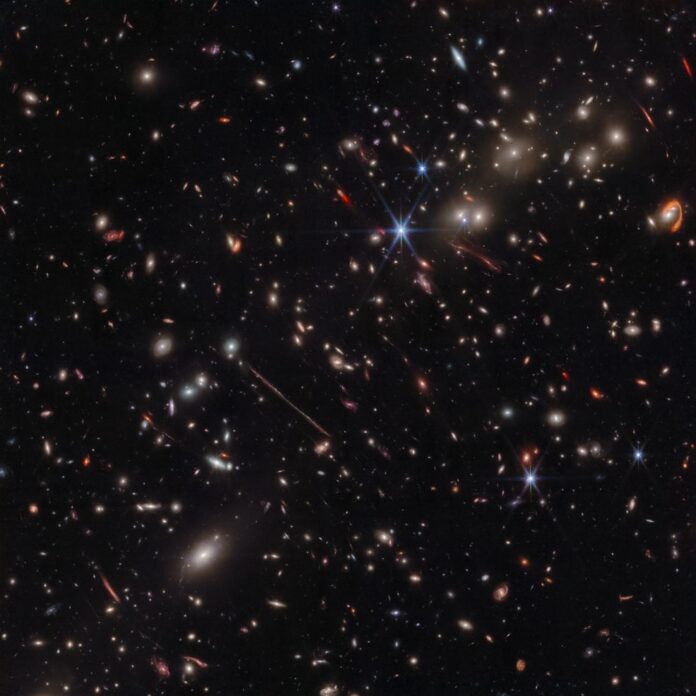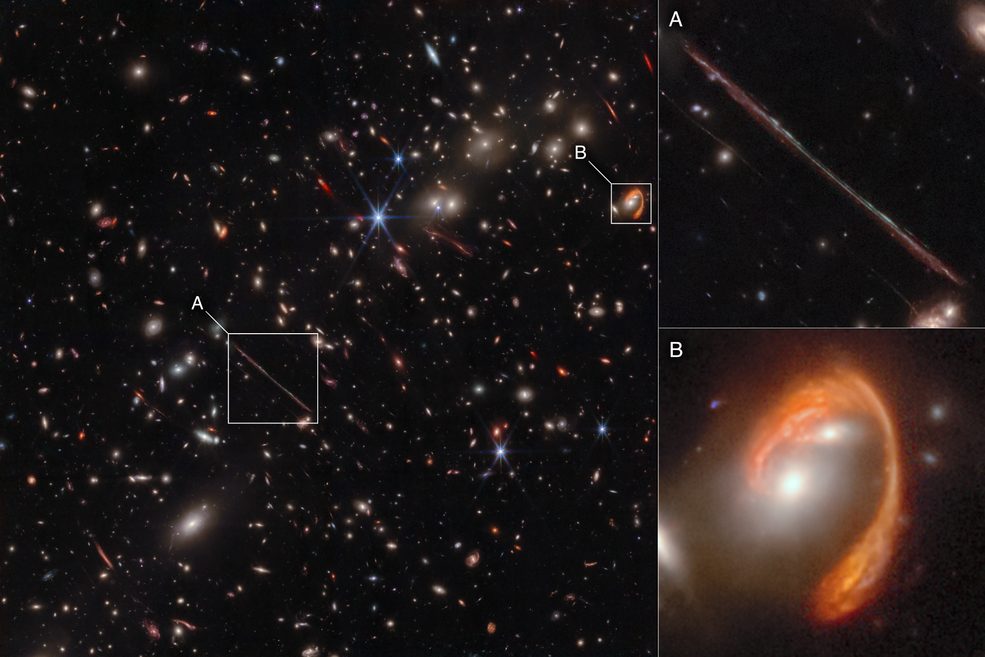
The infrared image, taken by the James Webb Space Telescope, shows many unusual, distorted background galaxies that were only hinted at in previous Hubble images.
El Gordo is a cluster of hundreds of galaxies that existed when the Universe was 6.2 billion years old, making it a “cosmic teenager.” It is the most massive cluster that existed at that time.
The team set their sights on El Gordo because it acts as a natural cosmic magnifying glass through a phenomenon known as gravitational lensing. Its powerful gravity bends and distorts the light of objects lying behind it, much like an eyeglass lens.
Brenda Fry of the University of Arizona said:
“Lensing by El Gordo boosts the brightness and magnifies the sizes of distant galaxies. This lensing effect provides a unique window into the distant universe.”
Fry is one of the leaders of the PEARLS-Clusters division of the PEARLS team (Principal Extragalactic Areas for Reionization and Lensing) and lead author of one of the four papers analyzing the El Gordo observations.
Fish hook
In the image of El Gordo, one of the most striking features is the bright arc shown in red in the upper right corner. The light from this galaxy took 10.6 billion years to reach Earth. Its distinctive red color is due to a combination of reddening from dust within the galaxy itself and cosmological redshift due to its extreme distance.
By correcting for distortions created by the lenses, the team was able to determine that the background galaxy is disk-shaped, but is only 26 thousand light-years across – about one-quarter the size of the Milky Way. They were also able to study the star formation history of the galaxy, finding that star formation is already rapidly declining in the center of the galaxy, a process known as quenching.
Patrick Kamineski of Arizona State University, lead author of the second paper, notes:
“We were able to carefully dissect the shroud of dust that envelops the galaxy center where stars are actively forming.”
With Webb, he says, scientists can easily peer through this thick veil of dust to see the assembly of galaxies from the inside.

A fine line
Another notable feature of the image is a long, pencil-thin line to the left of the center. Known as “La Flaca” (“The Thin One”), this is another lensed background galaxy whose light also took nearly 11 billion years to reach Earth.
Not far from La Flaca is another lensed galaxy. When the researchers closely examined this galaxy, they found a single red giant star, which they named Quillur.
Hubble had previously found other lensed stars (e.g., Earendel), but they were all blue supergiants. Quillur is the first single red giant star to be observed beyond 1 billion light-years from Earth. Such stars with a large redshift can only be detected using infrared filters and Webb sensitivity.
José Diego from the Instituto de Física de Cantabria in Spain, lead author of the third paper on El Gordo, said:
“It’s almost impossible to see lensed red giant stars unless you go into the infrared. This is the first one we’ve found with Webb, but we expect there will be many more to come.”
Galactic group and spots
Other objects in the Webb image, although less visible, are no less interesting from a scientific point of view. For example, Frye and her team identified five multi-lens galaxies that appear to be a cluster of baby galaxies that formed about 12.1 billion years ago. There are another dozen candidate galaxies that may also be part of this distant cluster.
“While additional data are required to confirm that there are 17 members of this cluster, we may be witnessing a new galaxy cluster forming right before our eyes, just over a billion years after the big bang,” SAYS FRY.
The final paper looks at very faint, speckle-like galaxies known as ultradiffuse galaxies. As the name suggests, these objects, which are scattered throughout the El Gordo cluster, have their stars widely scattered in space. The team identified some of the farthest superdiffuse galaxies ever observed, with light traveling 7.2 billion years to reach us.
Timothy Carlton of Arizona State University, lead author of the fourth paper, says that the scientists checked whether the properties of these galaxies differ from the ultradiffuse galaxies seen in the local Universe, and indeed there are some differences. In particular, they are bluer, younger, more elongated, and more evenly distributed throughout the cluster.
This suggests that living in the cluster environment for the past 6 billion years has had a significant effect on these galaxies,” HE SAYS.
Gravitational lensing was predicted by Albert Einstein more than 100 years ago. In the El Gordo cluster, astronomers see the power of gravitational lensing in action. Roger Windhorst of Arizona State University, principal investigator of the PEARLS program, emphasizes this:
“The PEARLS images of El Gordo are out-of-this-world beautiful. And, they have shown us how Webb can unlock Einstein’s treasure chest.”








